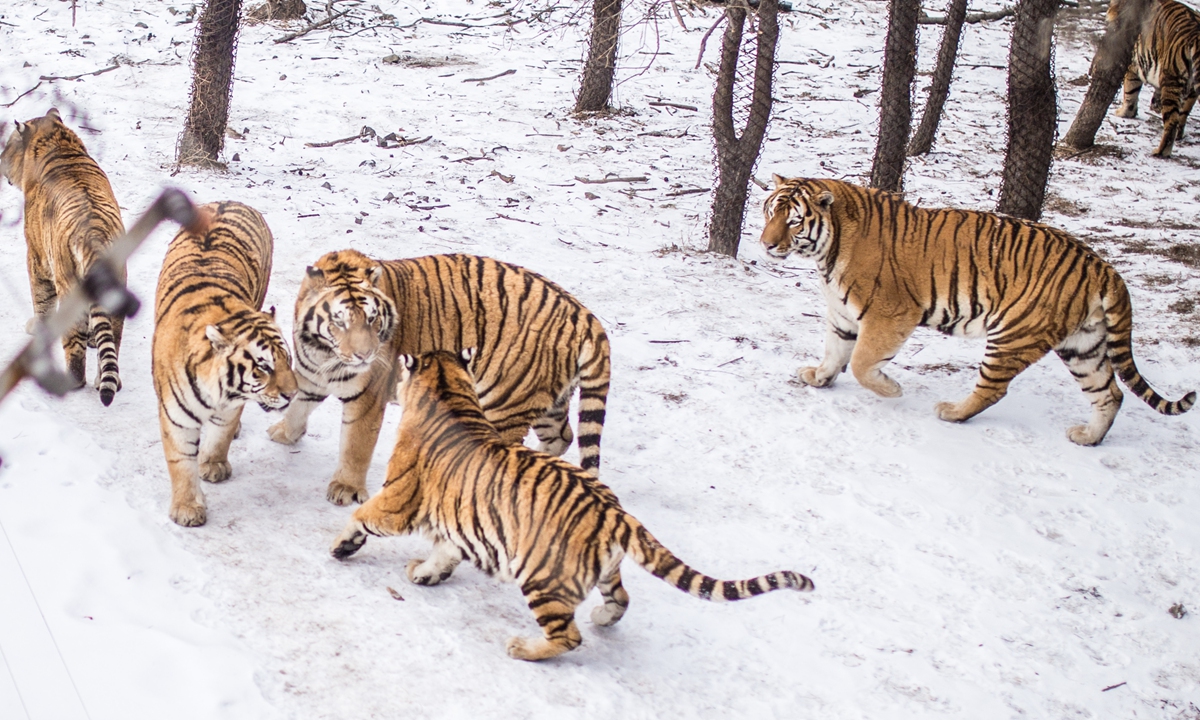
Siberian tigers Photo: Shan Jie/GT
More frequent appearances by wild animals have been observed in the part of the Northeast China Tiger and Leopard National Park located in Hunchun, Northeast China's Jilin Province, by a comprehensive air, space and land system, showing an increase in the amount of wildlife in the area and an improvement in the ecological environment after years of efforts to protect Siberian tigers and Amur leopards in northeastern China, the Global Times learned from the park on Tuesday.
Now Siberian tigers can be seen nearly every day, according to Li Wanlu who works at the monitoring center and observes wildlife in the park via an air-space-land comprehensive monitoring system.
The more frequent appearance of Siberian tigers captured by the system demonstrates the improvement of the ecological environment in the park, which has led to an increase in the number of wild animals in the area, Li told the Global Times.
According to data released in October 2021, the number of wild Siberian tigers in the park has increased from 27 to 50 since the start of the pilot program, while that of Amur leopards has increased from 42 to 60, with more than 10 tiger cubs and seven leopard cubs discovered.
As one of the first national parks in China, the Northeast China Tiger and Leopard National Park started pilot operation in January 2017, covering a planned area of 14,065 square kilometers.
The park has a mission to protect wildlife populations and aims to gain more wildlife conservation experience. It incorporates as many relevant habitats as possible and practices whole-process conservation measures in a holistic manner.

Northeast China Tiger and Leopard National Park Photo: Shan Jie/GT
In the early days of the establishment of the park, patrols and monitoring basically depended on manpower. In February 2018, the Northeast China Tiger and Leopard Monitoring and Research Center of the National Forestry and Grassland Administration was inaugurated at Beijing Normal University. Since then, a comprehensive system that integrates air, space and land has been tested within 500 square kilometers of the park for the real-time monitoring of information and dynamics of wild animals and human activities, using modern communication, artificial intelligence, cloud computing and other high-tech means, according to the website of the Jilin provincial government.
Today, more than 5,700 infrared cameras have been placed in the park, Meng Xin, an expert on infrared camera monitoring in the park, told the Global Times.
The comprehensive system allows staff to monitor the park in real time and saves a lot of human and material resources, reducing the data collection workload, according to the local government.
It is the only real-time monitoring system in the world that achieves the full coverage of large national parks. It can not only transmit high-definition images and videos in real time, but also collect and transmit ecological information about soil, water and air via sensors, the government said.
The monitoring center uses the system to observe the activities of wild animals in the park and record their activities. The park also uses artificial intelligence technology to analyze the data to guarantee correctness and accuracy, Li said.
Li said she and her five other colleagues are also conducting a 24-hour early warning system to detect whether human beings enter the park or animals enter villages, to prevent conflicts between humans and wild animals.




